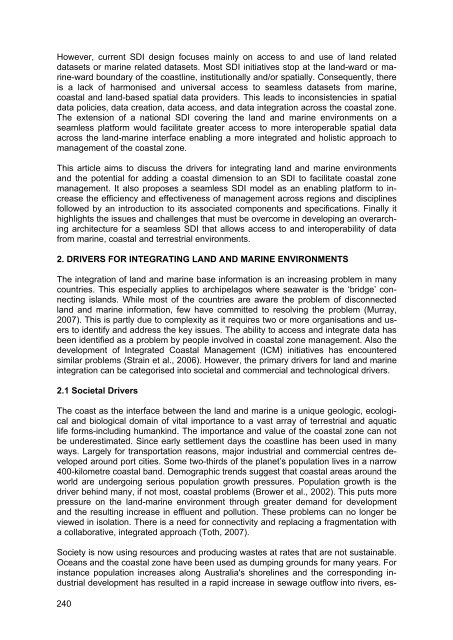SDI Convergence - Nederlandse Commissie voor Geodesie - KNAW
SDI Convergence - Nederlandse Commissie voor Geodesie - KNAW
SDI Convergence - Nederlandse Commissie voor Geodesie - KNAW
You also want an ePaper? Increase the reach of your titles
YUMPU automatically turns print PDFs into web optimized ePapers that Google loves.
However, current <strong>SDI</strong> design focuses mainly on access to and use of land related<br />
datasets or marine related datasets. Most <strong>SDI</strong> initiatives stop at the land-ward or marine-ward<br />
boundary of the coastline, institutionally and/or spatially. Consequently, there<br />
is a lack of harmonised and universal access to seamless datasets from marine,<br />
coastal and land-based spatial data providers. This leads to inconsistencies in spatial<br />
data policies, data creation, data access, and data integration across the coastal zone.<br />
The extension of a national <strong>SDI</strong> covering the land and marine environments on a<br />
seamless platform would facilitate greater access to more interoperable spatial data<br />
across the land-marine interface enabling a more integrated and holistic approach to<br />
management of the coastal zone.<br />
This article aims to discuss the drivers for integrating land and marine environments<br />
and the potential for adding a coastal dimension to an <strong>SDI</strong> to facilitate coastal zone<br />
management. It also proposes a seamless <strong>SDI</strong> model as an enabling platform to increase<br />
the efficiency and effectiveness of management across regions and disciplines<br />
followed by an introduction to its associated components and specifications. Finally it<br />
highlights the issues and challenges that must be overcome in developing an overarching<br />
architecture for a seamless <strong>SDI</strong> that allows access to and interoperability of data<br />
from marine, coastal and terrestrial environments.<br />
2. DRIVERS FOR INTEGRATING LAND AND MARINE ENVIRONMENTS<br />
The integration of land and marine base information is an increasing problem in many<br />
countries. This especially applies to archipelagos where seawater is the ‘bridge’ connecting<br />
islands. While most of the countries are aware the problem of disconnected<br />
land and marine information, few have committed to resolving the problem (Murray,<br />
2007). This is partly due to complexity as it requires two or more organisations and users<br />
to identify and address the key issues. The ability to access and integrate data has<br />
been identified as a problem by people involved in coastal zone management. Also the<br />
development of Integrated Coastal Management (ICM) initiatives has encountered<br />
similar problems (Strain et al., 2006). However, the primary drivers for land and marine<br />
integration can be categorised into societal and commercial and technological drivers.<br />
2.1 Societal Drivers<br />
The coast as the interface between the land and marine is a unique geologic, ecological<br />
and biological domain of vital importance to a vast array of terrestrial and aquatic<br />
life forms-including humankind. The importance and value of the coastal zone can not<br />
be underestimated. Since early settlement days the coastline has been used in many<br />
ways. Largely for transportation reasons, major industrial and commercial centres developed<br />
around port cities. Some two-thirds of the planet’s population lives in a narrow<br />
400-kilometre coastal band. Demographic trends suggest that coastal areas around the<br />
world are undergoing serious population growth pressures. Population growth is the<br />
driver behind many, if not most, coastal problems (Brower et al., 2002). This puts more<br />
pressure on the land-marine environment through greater demand for development<br />
and the resulting increase in effluent and pollution. These problems can no longer be<br />
viewed in isolation. There is a need for connectivity and replacing a fragmentation with<br />
a collaborative, integrated approach (Toth, 2007).<br />
Society is now using resources and producing wastes at rates that are not sustainable.<br />
Oceans and the coastal zone have been used as dumping grounds for many years. For<br />
instance population increases along Australia's shorelines and the corresponding industrial<br />
development has resulted in a rapid increase in sewage outflow into rivers, es-<br />
240

















